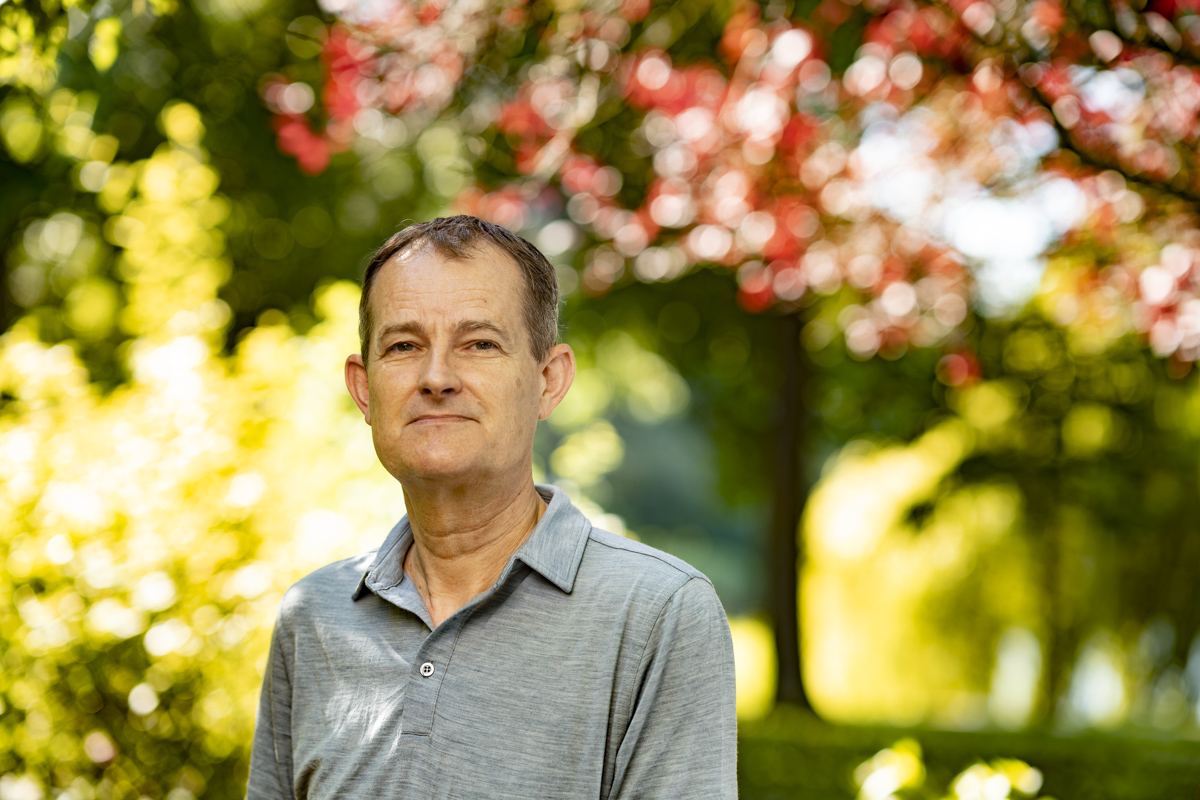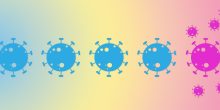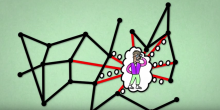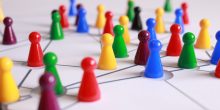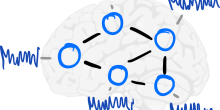Prof. dr. ir. Hans Heesterbeek, one of the leading infectious disease epidemiologists in the Netherlands, is a busy man.
Especially at the time of this interview that took place in the middle of the second wave of COVID-19 infections, where there was still a lot unclear about the virus and how effective the measures were. But even now, in the third wave of infections and with a lot more knowledge about the viral disease, the work of epidemiologists remains an invaluable tool in creating government policy and predicting the effect of several measures. Heesterbeek also has to deal with very different kinds of waves: waves of journalists calling him, asking for his opinion on the impact of (potential) policy, how long the lockdown will last and what will happen next. When he is not busy talking to all these journalists, he leads a Covid-19 project with a diverse group of experts. This team of experts is trying to answer questions like: how well should we monitor the spread of the virus with testing and contact tracing to slow it? How strictly does the population have to follow the rules to prevent the spread? Are we even following the right rules?
Fortunately for us, Hans Heesterbeek had a gap in his schedule to yet again answer some questions, this time not asked by professional journalists, but by us, four students from the Technical University in Eindhoven.
In this article, we will discuss several challenges Heesterbeek and the Netherlands as a whole are facing during this pandemic. We will start with the Corona app and take some time to discuss the basic reproduction number  . Then, we will dive into the psychological aspect of a lockdown. We will end the article by looking ahead to the future: how can we prepare ourselves for the next pandemic?
. Then, we will dive into the psychological aspect of a lockdown. We will end the article by looking ahead to the future: how can we prepare ourselves for the next pandemic?
Corona app
At the time of the interview, the research project of Hans Heesterbeek was mainly working on the Corona app (CoronaMelder). The most important question there was to determine mathematically how big the impact of the app would be.
After this prediction, we will discuss what the actual effect has been of the app until now.
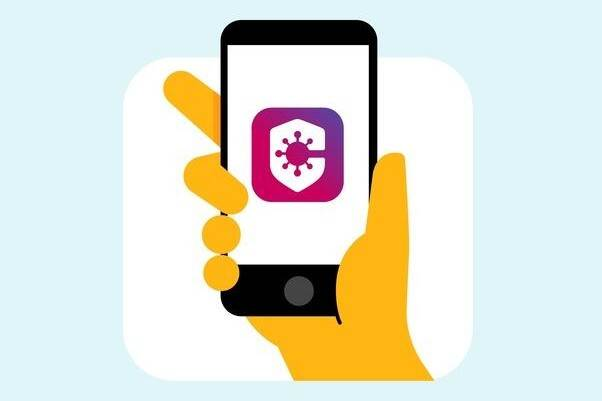
To be able to give a prediction, Heesterbeek mentioned the time delay between a person showing symptoms and the moment that they are tested positively and actually do something to notify others.
He explained that this time delay is simply too large: “For this disease it is a bit like the flu, although the flu spreads a bit faster”, he states, “you are infectious for only two days but you are infectious even before you have any symptoms. If you think: ‘I might have the flu, I need to stay home’, you have made your new cases already. The flu is something that is completely impossible to stop with contact tracing and isolation/quarantine, since by the time you think there is something to be traced, you have already made your  contacts. The same happens with a few more days of delay here [with COVID-19].”
contacts. The same happens with a few more days of delay here [with COVID-19].”
This  , the basic reproduction number, is the average number of people that are infected by one infectious individual (if we assume there is no immunity in the population) (see also this article, source: Network Science - Albert Barabási). The value of this
, the basic reproduction number, is the average number of people that are infected by one infectious individual (if we assume there is no immunity in the population) (see also this article, source: Network Science - Albert Barabási). The value of this  for the novel Coronavirus is highly dependent on human contact - seeing as COVID spreads through the air. Intuitively, one would be able to reason that the more people an individual infects (so the bigger the value of
for the novel Coronavirus is highly dependent on human contact - seeing as COVID spreads through the air. Intuitively, one would be able to reason that the more people an individual infects (so the bigger the value of  ), the harder it is to contain the virus. Conversely, the smaller
), the harder it is to contain the virus. Conversely, the smaller  is, the slower it spreads and if the value is less than 1, the disease is in the process of being eradicated.
is, the slower it spreads and if the value is less than 1, the disease is in the process of being eradicated.
Within the field of Network Science it has been found that the time necessary for a disease to infect every single member of a population is inversely proportional to the value of  (Barabási). As there is no known or functional way of granting people immunity to COVID-19, the only way to lower
(Barabási). As there is no known or functional way of granting people immunity to COVID-19, the only way to lower  is to prevent and minimize the possibility of infection. While the app was in development, Heesterbeek was not very optimistic in regards to its effectiveness.
is to prevent and minimize the possibility of infection. While the app was in development, Heesterbeek was not very optimistic in regards to its effectiveness.
For example, there was the possibility that not everyone uses the app. Not everyone even has a smartphone, and one could reason that especially groups of individuals who are the most susceptible to the virus, that is, the elderly, are the least likely to own a smartphone. Moreover, having the app on your phone and allowing it to do its contact tracing are two very different things. “And even if everyone has a smartphone, it is the time delay that messes things up, that makes that you often are too late in finding people before they pass on the infection to others.”
Remembering people you have come in contact with after a positive test should of course be easy in a lockdown, but lately there’s been word of opening things up again, though the actual date for when this would take place has been pushed back. This would mean that you again might come in contact with all kinds of people: going to school, to the supermarket, public transport et cetera. “But still, the delay is the thing that kills it, we will see how it goes but I don’t have high expectations of the app. We might find some people surely, but it is not going to be enough in my opinion.” In short: CoronaMelder cannot be of great help, even in the ideal case that everyone uses it, so we have to look elsewhere for additional solutions to mitigate the spread of COVID-19.
On the other hand the app might notify a few people that would otherwise have started a so-called superspreader event, for example. A superspreader event is an event where one infected individual infects way more other individuals than usual. Furthermore, even though with the app you find a small percentage of all contacts, you do find more than the contacts that people remember by themselves, when asked by the GGD.
Now, several months later, the government has published a report about the effectiveness of the app (news article). The most important result is that apparently 58% of the app users receiving a notification that they have been in contact with someone who tested positive, was not contacted by the GGD. Without the app, this group would thus not have been informed as early or even at all. However, no data is available on how long the time delay was between the contact and the CoronaMelder notification. Hence, it might be the case that a person notified by the app has already infected the people close to them.
As far as finding people that have possibly been infected, to aid regular contact tracing by the GGD, CoronaMelder is doing well. Nevertheless, it was found that a person showing COVID symptoms was not significantly more likely to get tested than a person without symptoms, which is troublesome. Also, just 45% of the group that receives a notification actually stays home for the advised period. In conclusion, there are some subtleties about the report findings, so it remains unclear what the exact role of CoronaMelder is in mitigating the spread of the coronavirus. Furthermore, it is mentioned that more people should use the app for it to be really effective in preventing the spread of the virus.
Since CoronaMelder alone is thus probably not sufficient to combat the virus, and the third wave does not seem to be dying out quickly enough (statistics in the Netherlands), the government had to resort to stricter measures. These have included, for example, restrictions on group sizes, on what activities are allowed to open, and on how many people can visit each other. Other countries even imposed an ulterior national lockdown - though others, such as the UK, are reopening thanks to an efficient vaccination plan.
Psychology of the lockdown
Initiating a lockdown and restricting the movement of the general public seemed like a straightforward thing to do when the number of infected people rose. It would simply limit the movement of the virus and after a couple of weeks it would die out. However, nothing could be further from the truth. In the past months, with fluctuating levels of restrictions, we have all seen the true implications of the corona measures on the ecosystem that our society forms: poorer mental health, increased feelings of loneliness and reduced access to medical care to begin with. Many of the subtle side effects of the lockdown could not have been predicted and policy makers have often not paid that much attention to the more subtle external effects. Heesterbeek: “People in the infectious disease field […] have for decades said that this [a major pandemic] will happen. Now it has happened. What we couldn’t predict was how the pandemic influences things in all little bits in the complex system we call society. Everything is affected. There are cascades of effects both socially and economically”.
These cascades of effects are becoming clearer and clearer in today’s society. Multiple conspiracy theories have emerged that essentially blame the government, China or other powerful people such as Bill Gates for the coronavirus. There are even those who claim that Corona isn’t even real. These theories have led to multiple politicians, mainly prime minister Rutte and minister of health De Jonge being threatened and called “satanic pedophiles”. Unfortunately, with today’s internet climate, where fake news is so prevalent, it is no surprise that some people eventually start to believe these absurd theories. It is an established fact that algorithms of streaming services like YouTube tend to suggest wild conspiracy theories over long technical scientific debates on the topic, as the shock value that these conspiracies have, makes people want to watch more. It is a sad truth, however, that we have mostly our own lack of following the rules to blame for the ongoing pandemic.
Heesterbeek: “It should be very clear to the people [that they need to] start to follow the rules that are in place after the first lockdown such as basic hygiene rules, distancing whenever possible, facemasks if not possible, don’t travel if you are sick, get yourselves tested and stay at home as much as possible. If we would really adhere to these rules, then I think we would be able to manage, but the problem is that we don’t. You get all these flare-ups because of some major transmission events.”
I think we did enough in the beginning, but that we were much too relaxed in the summer months after the first wave had passed.
On the other hand, how can you expect the general public to follow all the “rules”, when they are, in fact, only “advice” and “recommendations”? The government, and especially prime minister Rutte, talk about the Netherlands being an “adult” country with “smart” people that know to follow these recommendations. This approach to counter measures leaves way too much freedom for people to choose whether they follow the guidance of the government. Clearly no one truly wants to follow the rules, but we can all agree that it is better if we do so anyway. The government has partly forsaken their paternalistic duty to be stern and demand compliance to their rules through laws and fines.

Heesterbeek: “I think we did enough in the beginning, but that we were much too relaxed in the summer months after the first wave had passed. I think that there were some communication issues: there is a difference between giving advice and saying that something cannot be done”.
Of course, the optimal course of action is to prevent a pandemic altogether. In this case, we have to balance the potential costs of a next pandemic and the costs that are accompanied by these preventions. However, due to the intrinsic nature of society, there are many components that interact with each other in unpredictable ways. Because of this unpredictability, it is unclear what would be the best measures to prevent such a major pandemic. Only by analyzing the enormous amounts of data that have been collected about the spread of the virus and the efficacy of the counter measures can scientists begin to design future methods of prevention. Even then, it is impossible to predict, let alone prevent, all possible interactions of the complex system that is the biosphere.
Planning for the future
After having seen the effects of this pandemic first-hand, it is of great interest to find ways of preventing such an event from happening again or, at the very least, lessening its impact and shortening its lifespan. Upon asking Heesterbeek how this can be done, he mentioned two aspects that are crucial to the spread of pandemics: the appearance of a new virus and the first response from governing bodies to an outbreak.
One way to prevent pandemics from happening is to study how these new viruses pass onto humans. In other words, what do we do that encourages these transmissions from both domestic animals for food production and wild animals to humans? Heesterbeek poses the question: “How far are we willing to go to prevent these interactions and this impact that we have on ecosystems?”. Furthermore, what do we do that encourages the spreading of new viruses among humans? The next question to ask is, once this information has been found, will we be able to adapt? “Does this mean, for example, that our interactions with each other change? Are we going to fly everywhere again with the same frequency in the same number of people in a few years’ time?”.
Before COVID hit, the data on pandemics at our disposal was small, as we never really had gone through such a large-scale crisis (and had the means to record data that surfaced in this modern age). Now we have collected a large wealth of it. The first recommendation Heesterbeek gives is that we use it to study this kind of disease and how it spreads: "[…] The emphasis should be on respiratory viruses in general, and the emphasis should not really necessarily be only on SARS-Coronavirus because it could be another virus completely next time". He summed it up by saying: "If we want to be prepared, we need to be prepared more broadly".
He suggests we could perhaps come up with a generic vaccine, a more general solution to respiratory viruses as a whole: “What are the likely candidates for a new pandemic? Very, very probably another respiratory infection: a flu virus, another coronavirus and there are a few additional families. Focus on those, see if you can make a generic vaccine, a generic antibody that you can give to people. Can you make generic diagnostic tests?”. Naturally, it will not be perfect, and will only be able to act as a deterrent - that is, it will be a measure that will not eliminate the virus, but only slow down the rate at which it spreads. However, by using that and social distancing norms, masks included, we may be able to buy enough time to find a vaccine.
Naturally, he adds, it is necessary to increase funding to research. It will be a huge cost, surely, to do all this.
In order to be timely and prove useful, the research is to be undertaken before a new pandemic strikes. Namely, we need to understand what measures should be put in place from the very beginning, so as to contain and reduce the impact of the next epidemic as effectively as we can. Heesterbeek mentions that one way would be to restrict behaviors that encourage the appearance of new viruses: “What is it that we do in the world that has increased the opportunities for transmission to humans? […] What needs to be put into place can range from a restriction or a complete ban on transporting live wild animals or shooting wild animals in all sorts of parts of the world and eating them. All of these things can lead to exposure to unknown pathogens”.
Does this mean, for example, that our interactions with each other will change?
In conclusion, we have discussed the effects of lockdowns, as well as the pro and cons of using an app to track corona spread. We furthermore have seen what sort of preparations for the future we should consider, as we can make predictions on what the next epidemic will be like.
“There is a lot to do, I think”- Heesterbeek states, near the end of the interview.
He emphasizes, however, something that we encourage everyone to think about as a closing statement of this interview: “The question is how far the world wants to go.”.
A pandemic will definitely happen again after all, and as this interview has clearly shown, we have the choice of letting the virus find us unprepared once more; or to be able to fight back and, hopefully, not have another crisis. The question is, indeed, how far we want to go.
We have the means to do so. The advancements made during this crisis, in the medical field and overall with regards to technology, have been massive. We have the data to do so. And we have a good reason to do so.
“How far does the world want to go?”- really is the only question that could stop us now. And if there is one takeaway to be taken from this interview, it is that we should not relax again and say it’s all over. We should go further, so that the next time another virus appears, we won’t face a crisis. We will be able to overcome it.

